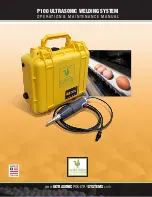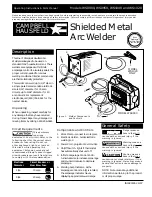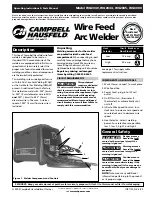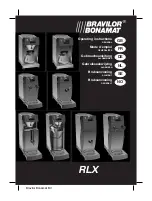
SECTION 3 - CHASSIS & TURNTABLE
3120746
– JLG Lift –
3-57
Changing from LP Gas to Gasoline
1. With engine operating on LP under a no load condi-
tion, throw the LPG/Gasoline switch at the ground
control station to the “Gasoline” position.
2. If engine “stumbles” because of lack of gasoline,
place the switch to the LPG position until engine
regains smoothness, then return the switch to the
Gasoline position. Repeat as necessary until engine
runs smoothly on gasoline.
3. Close the hand valve on the LP gas supply tank by
turning clockwise.
3.18 ELECTRIC GOVERNOR INSTALLATION
AND ADJUSTMENTS - FORD ENGINE
General
These instructions presume no electrical test equipment
other than a multimeter for making the electrical measure-
ments called for on the following pages. If no suitable
meter is available, an inexpensive but adequate meter,
part number 22-188 is available from any local Radio
Shack store.
Many “governor problems” turn out to be installation
problems, particularly in first-time applications. Careful
attention to the directions provided will go far toward a
successful installation made in the least amount of time.
Quick-start Installations
If you are experienced in installing and adjusting Electric
Governor, follow these steps. Otherwise, refer to the more
detailed instructions starting with “MOUNTING-ACTUA-
TOR”.
1. Mount Actuator rigidly to engine location which will
permit a short, straight linkage to the carburetor or
fuel valve. Avoid very hot areas.
2. Mount controller in a dry, fairly cool location. Acces-
sibility for adjusting is required.
3. Wire per appropriate included schematic, using #16
wire.
4. Set up fuel linkage. This is critical, so review the sec-
tion titled “LINKAGE”.
5. Hold linkage for safety, and start engine.
6. Adjust engine speed to desired valve using High
Engine pot. Turn CW to increase, CCW to decrease
speed. (See diagram on page 43 E-331 Electronics -
Adjustment Locations.)
Mounting-Actuator
The Actuator may be mounted in any attitude — there is
no preferred orientation.
With no power applied, the Actuator is spring-loaded to
the minimum fuel position. The Actuator output shaft
rotates toward the maximum fuel position against this
spring through electrical power from the controller. This
rotation is CW (clockwise) on one side of the Actuator, and
CCW (counterclockwise) on the other. If necessary,
reverse the Actuator on its mounting plate so that the
desired direction of rotation is on the desired side to
match the fuel system direction of travel.
Before selecting the mounting location, consider the link-
age that will be required to connect the Actuator output
arm to the butterfly or fuel valve. Read the following sec-
tion on linkages before deciding on a mounting location!
Mount Actuator rigidly to engine location which will permit
a short, straight linkage to the carburetor or fuel valve.
Avoid very hot areas.
Linkage
1/4" -28 threaded rod and low friction rod-end bearings
are recommended for linkage materials.
Keep the linkage as short and as straight as possible.
The linkage must not rub against the engine, brackets,
hoses, etc. The linkage must be free of friction and lost
motion or “slop”.
The following sketch indicates the proper linkage geome-
try for most installations.
Note that the angle between the carburetor arm and the
rod is 70 degrees with the engine at idle. This is highly
desirable! Note also that the Actuator arm travels equally
on either side of a 90 degree angle with the rod. This
angular arrangement will give the proper mechanical gain
for good stability and performance. It may be necessary to
rotate the carburetor arm relative to the butterfly to
achieve this. This can usually be done, and is usually
worth the effort! Below are some workable installations,
Summary of Contents for 601S
Page 1: ...Service and Maintenance Manual Model 601S P N 3120746 November 22 2016 ...
Page 2: ......
Page 4: ... JLG Lift THIS PAGE LEFT BLANK INTENTIONALLY ...
Page 16: ...x JLG Lift 3120746 TABLE OF CONTENTS Continued This page left blank intentionally ...
Page 26: ...SECTION 1 SPECIFICATIONS 1 10 JLG Lift 3120746 Figure 1 3 Torque Chart ...
Page 36: ...SECTION 2 GENERAL 2 10 JLG Lift 3120746 Figure 2 7 Connector Installation ...
Page 40: ...SECTION 2 GENERAL 2 14 JLG Lift 3120746 This page left blank intentionally ...
Page 49: ...SECTION 3 CHASSIS TURNTABLE 3120746 JLG Lift 3 9 Figure 3 1 Torque Hub Drive Fairfield ...
Page 51: ...SECTION 3 CHASSIS TURNTABLE 3120746 JLG Lift 3 11 Figure 3 2 Torque Hub Drive Auburn Gear ...
Page 53: ...SECTION 3 CHASSIS TURNTABLE 3120746 JLG Lift 3 13 Figure 3 3 Drive Brake Assembly Ausco ...
Page 91: ...SECTION 3 CHASSIS TURNTABLE 3120746 JLG Lift 3 51 Figure 3 40 Swing Brake Assembly Ausco ...
Page 99: ...SECTION 3 CHASSIS TURNTABLE 3120746 JLG Lift 3 59 ...
Page 119: ...SECTION 3 CHASSIS TURNTABLE 3120746 JLG Lift 3 79 Figure 3 46 EFI Component Location ...
Page 122: ...SECTION 3 CHASSIS TURNTABLE 3 82 JLG Lift 3120746 Figure 3 47 ECM EPM Identification ECM EPM ...
Page 128: ...SECTION 3 CHASSIS TURNTABLE 3 88 JLG Lift 3120746 This page left blank intentionally ...
Page 132: ...SECTION 4 BOOM PLATFORM 4 4 JLG Lift 3120746 Figure 4 5 Boom Assembly Cutaway Sheet 1 of 2 ...
Page 133: ...SECTION 4 BOOM PLATFORM 3120746 JLG Lift 4 5 Figure 4 6 Boom Assembly Cutaway Sheet 2 of 2 ...
Page 145: ...SECTION 4 BOOM PLATFORM 3120746 JLG Lift 4 17 Figure 4 22 Rotator Assembly Helac ...
Page 148: ...SECTION 4 BOOM PLATFORM 4 20 JLG Lift 3120746 This page left blank intentionally ...
Page 174: ...SECTION 5 HYDRAULICS 5 26 JLG Lift 3120746 This page left blank intentionally ...
Page 176: ...SECTION 6 JLG CONTROL SYSTEM ADE 6 2 JLG Lift 3120746 Figure 6 1 EPBCS Block Diagram ...
Page 238: ...SECTION 7 SCHEMATICS 7 16 JLG Lift 3120746 Figure 7 15 Hydraulic Schematic Sheet 1 of 4 ...
Page 240: ...SECTION 7 SCHEMATICS 7 18 JLG Lift 3120746 Figure 7 17 Hydraulic Schematic Sheet 3 of 4 ...
Page 242: ...SECTION 7 SCHEMATICS 7 20 JLG Lift 3120746 This page left blank intentionally ...
Page 243: ......
















































